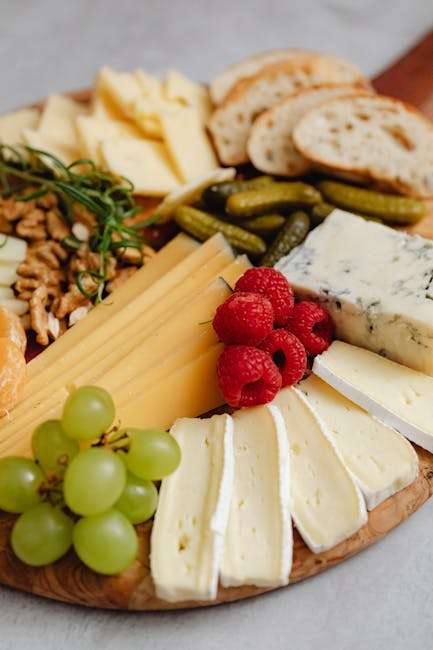How to Create the Perfect Charcuterie Board
There’s something magical about a well-crafted charcuterie board. It’s not just a feast for the taste buds but also a visual delight that can elevate any occasion, from intimate gatherings to grand celebrations. Whether you’re a seasoned host or a newbie in the world of hosting, creating the perfect charcuterie board is an art worth mastering. In this guide, we’ll walk you through the essentials of crafting a board that is both delicious and aesthetically pleasing. ??
Table of Contents
1. Introduction
2. What is a Charcuterie Board?
3. Essential Components of a Charcuterie Board
4. How to Choose the Right Board
5. Selecting the Perfect Meats and Cheeses
6. Adding Fruits, Nuts, and Extras
7. Arranging Your Board Like a Pro
8. Conclusion
9. FAQ
What is a Charcuterie Board? ?
Charcuterie is a French term that refers to the art of preparing and assembling cured meats. A charcuterie board typically includes a variety of meats, cheeses, fruits, nuts, and other accompaniments arranged beautifully on a platter. It’s a versatile appetizer that can be customized to fit any taste or dietary preference, making it a favorite among hosts and guests alike.
Essential Components of a Charcuterie Board ??
To create a well-balanced charcuterie board, you’ll need an assortment of ingredients that complement each other in flavor, texture, and color. Here’s what you’ll need:
Meats
Include a variety of cured meats such as prosciutto, salami, and chorizo. These provide savory flavors and different textures.
Cheeses
Offer a selection of cheeses with varying textures and flavors. Consider including a soft cheese like brie, a hard cheese like aged cheddar, and a blue cheese for those who enjoy stronger flavors.
Fruits and Nuts
Fresh fruits like grapes, figs, and apples add sweetness and juiciness, while nuts like almonds and walnuts provide a satisfying crunch.
Bread and Crackers
Offer an assortment of bread and crackers to complement the meats and cheeses. Think baguette slices, whole-grain crackers, and breadsticks.
Extras
Consider adding olives, pickles, and spreads like honey or mustard for added flavor and variety.
How to Choose the Right Board ?
The board itself plays a crucial role in the presentation. You can opt for a wooden board for a rustic feel, a marble slab for a more elegant look, or even a large platter if you’re serving a crowd. Ensure your board is large enough to hold all your components without overcrowding them.
Selecting the Perfect Meats and Cheeses ??
When selecting meats and cheeses, consider the preferences of your guests. Do they prefer mild or bold flavors? Are there any dietary restrictions to keep in mind? A good rule of thumb is to provide a mix of familiar options and a few adventurous choices to cater to all palates.
Adding Fruits, Nuts, and Extras ??
Fruits and nuts are not just fillers; they play a key role in enhancing the flavor profile of your board. Choose fruits that are in season for the best flavor, and consider toasting nuts lightly to bring out their natural oils and intensify their flavor.
Arranging Your Board Like a Pro ??
Now comes the fun part—arranging your board! Start by placing the larger items like cheeses and small bowls (for dips and spreads) on the board. Then, arrange the meats around the cheeses, folding or rolling them for visual interest. Fill in the gaps with fruits, nuts, and extras. Don’t be afraid to get creative with your arrangement; after all, the goal is to make it as appealing to the eyes as it is to the palate.
Conclusion
Creating the perfect charcuterie board is all about balance and creativity. By combining a variety of flavors, textures, and colors, you can craft a board that’s sure to impress. Remember, the best charcuterie boards are those made with love and a touch of personal flair. So, roll up your sleeves, let your creativity flow, and enjoy the delicious art of charcuterie. ?
FAQ
Q: Can I make a charcuterie board in advance?
A: Yes, you can prepare most components in advance. Just wait to add fresh fruits and bread until right before serving to keep them fresh.
Q: What if my guests have dietary restrictions?
A: You can easily accommodate dietary restrictions by including gluten-free crackers, dairy-free cheeses, or plant-based meats.
Q: How much should I prepare per person?
A: As a general guideline, plan for about 2 ounces of meat and 1-2 ounces of cheese per person. Adjust this based on the number of other items you include.
Q: What drinks pair well with a charcuterie board?
A: Wine is a classic choice, with red wine complementing bolder flavors and white wine pairing well with milder options. Don’t forget about craft beers, which can also be a great match!
